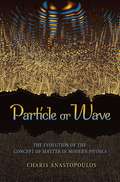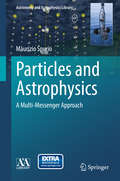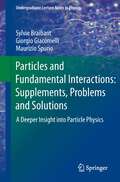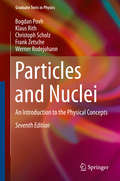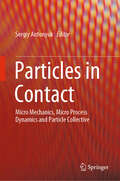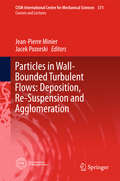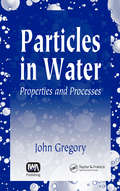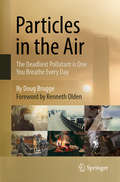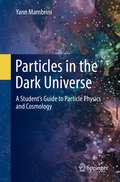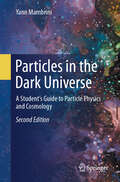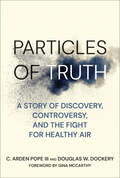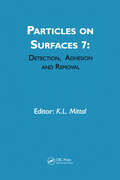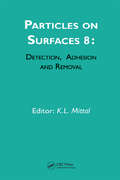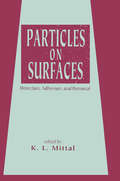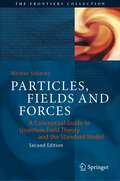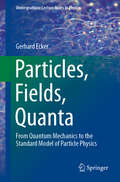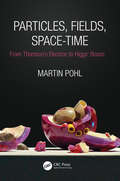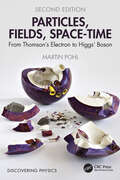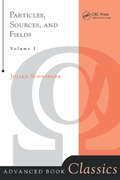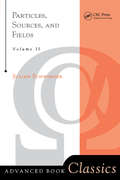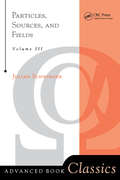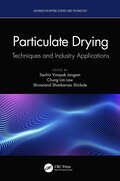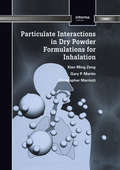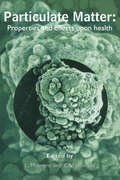- Table View
- List View
Particle or Wave: The Evolution of the Concept of Matter in Modern Physics
by Charis AnastopoulosParticle or Wave is the first popular-level book to explain the origins and development of modern physical concepts about matter and the controversies surrounding them. The dichotomy between particle and wave reflects a dispute--whether the universe's most elementary building blocks are discrete or continuous in nature--originating in antiquity when philosophers first speculated about the makeup of the physical world. Charis Anastopoulos examines two of the earliest known theories about matter--the atomic theory, which attributed all physical phenomena to atoms and their motion in the void, and the theory of the elements, which described matter as consisting of the substances earth, air, fire, and water. He then leads readers up through the ages to the very frontiers of modern physics to reveal how these seemingly contradictory ideas still lie at the heart of today's continuing debates. Anastopoulos explores the revolutionary contributions of thinkers like Nicolas Copernicus, Isaac Newton, and Albert Einstein. He shows how Einstein's ideas about relativity unify opposing concepts by identifying matter with energy, and how quantum mechanics goes even further by postulating the coexistence of the particle and the wave descriptions. Anastopoulos surveys the latest advances in physics on the fundamental structure of matter, including the theories of quantum fields and elementary particles, and new cutting-edge ideas about the unification of all forces. This book reveals how the apparent contradictions of particle and wave reflect very different ways of understanding the physical world, and how they are pushing modern science to the threshold of new discoveries.
Particles and Astrophysics
by Maurizio SpurioThis book is an introduction to "multi-messenger" astrophysics. It covers the many different aspects connecting particle physics with astrophysics and cosmology and introduces astrophysics using numerous experimental findings recently obtained through the study of high-energy particles. Taking a systematic approach, it comprehensively presents experimental aspects from the most advanced laboratories and detectors, as well as the theoretical background. The book is aimed at graduate students and post-graduate researchers with a basic understanding of particle and nuclear physics. It will also be of interest to particle physicists working in accelerator/collider physics who are keen to understand the mechanisms of the largest accelerators in the Universe. The book draws on the extensive lecturing experience of Professor Maurizio Spurio from the University of Bologna.
Particles and Fundamental Interactions
by Sylvie Braibant Maurizio Spurio Giorgio GiacomelliThe book provides theoretical and phenomenological insights on the structure of matter, presenting concepts and features of elementary particle physics and fundamental aspects of nuclear physics. Starting with the basics (nomenclature, classification, acceleration techniques, detection of elementary particles), the properties of fundamental interactions (electromagnetic, weak and strong) are introduced with a mathematical formalism suited to undergraduate students. Some experimental results (the discovery of neutral currents and of the W± and Z0 bosons; the quark structure observed using deep inelastic scattering experiments) show the necessity of an evolution of the formalism. This motivates a more detailed description of the weak and strong interactions, of the Standard Model of the microcosm with its experimental tests, and of the Higgs mechanism. The open problems in the Standard Model of the microcosm and macrocosm are presented at the end of the book. For example, the CP violation currently measured does not explain the matter-antimatter asymmetry of the observable universe; the neutrino oscillations and the estimated amount of cosmological dark matter seem to require new physics beyond the Standard Model. A list of other introductory texts, work reviews and some specialized publications is reported in the bibliography. Translation from the Italian Language Edition "Particelle e interazioni fondamentali" by Sylvie Braibant, Giorgio Giacomelli, and Maurizio Spurio Copyright © Springer-Verlag Italia, 2009 Springer-Verlag Italia is part of Springer Science+Business Media All Rights Reserved
Particles and Fundamental Interactions: Supplements, Problems and Solutions
by Sylvie Braibant Maurizio Spurio Giorgio GiacomelliThis volume is an exercises and solutions manual that complements the book "Particles and Fundamental Interactions" by Sylvie Braibant, Giorgio Giacomelli, and Maurizio Spurio. It aims to give additional intellectual stimulation for students in experimental particle physics. It will be a helpful companion in the preparation of a written examination, but also it provides a means to gaining a deeper understanding of high energy physics. The problems proposed are sometimes true and important research questions, which are described and solved in a step-by-step manner. In addition to the problems and solutions, this book offers fifteen Supplements that give further insight into topical subjects related to particle accelerators, signal and data acquisition systems and computational methods to treat them.
Particles and Nuclei
by Christoph Scholz Bogdan Povh Klaus Rith Frank Zetsche Werner RodejohannThis well-known introductory textbook gives a uniform presentation of nuclear and particle physics from an experimental point of view. The first part, Analysis, is devoted to disentangling the substructure of matter. This part shows that experiments designed to uncover the substructures of nuclei and nucleons have a similar conceptual basis, and lead to the present picture of all matter being constructed from a small number of elementary building blocks and a small number of fundamental interactions. The second part, Synthesis, shows how the elementary particles may be combined to build hadrons and nuclei. The fundamental interactions, which are responsible for the forces in all systems, become less and less evident in increasingly complex systems. Such systems are in fact dominated by many-body phenomena. A section on neutrino oscillations and one on nuclear matter at high temperatures bridge the field of "nuclear and particle physics" and "modem astrophysics and cosmology. The seventh revised and extended edition includes new material, in particular the experimental verification of the Higgs particle at the LHC, recent results in neutrino physics, the violation of CP-symmetry in the decay of neutral B-mesons, the experimental investigations of the nucleon's spin structure and outstanding results of the HERA experiments in deep-inelastic electron- and positron-proton scattering. The concise text is based on lectures held at the University of Heidelberg and includes numerous exercises with worked answers. It has been translated into several languages and has become a standard reference for advanced undergraduate and graduate courses.
Particles in Contact: Micro Mechanics, Micro Process Dynamics and Particle Collective
by Sergiy AntonyukThis book contains the latest scientific findings in the area of granular materials, their physical fundamentals and applications in particle technology focused on the description of interactions of fine adhesive particles.In collaboration between physicists, chemists, mathematicians and mechanics and process engineers from 24 universities, new theories and methods for multiscale modeling and reliable measurement of particles are developed, with a focus on:• Basic physical-chemical processes in the contact zone: particle-particle and particle-wall contacts,• Particle collisions and their dynamics• Constitutive material laws for particle systems on the macro level.
Particles in Wall-Bounded Turbulent Flows: Deposition, Re-Suspension and Agglomeration
by Jean-Pierre Minier Jacek PozorskiThe book presents an up-to-date review of turbulent two-phase flows with the dispersed phase, with an emphasis on the dynamics in the near-wall region. New insights to the flow physics are provided by direct numerical simuation and by fine experimental techniques. Also included are models of particle dynamics in wall-bounded turbulent flows, and a description of particle surface interactions including muti-layer deposition and re-suspension.
Particles in Water: Properties and Processes
by John GregoryBased on the author‘s more than 35 years of experience, Particles in Water: Properties and Processes examines particles and their behavior in water systems. The book offers clear and accessible methods for characterizing a range of particles both individually and as aggregates. The author delineates the principles for understanding particle
Particles in the Air: The Deadliest Pollutant is One You Breathe Every Day
by Doug BruggeThe book covers the three largest sources of particulate matter pollution in five chapters. These sources constitute three of the top ten public health problems in the world today and far outstrip any other environmental health threats in terms of health impact. The book begins with indoor solid fuel combustion for cooking in lower income countries and tells the story of how this problem was identified and recent efforts to eliminate it. The book next looks at tobacco smoking and second hand smoke, again reviewing the history of how these problems were identified scientifically and the fierce industry push back against the science. The last two chapters cover ambient particulate matter in the outdoor air. They address fine and ultrafine particles, describing the pioneering work on fine PM, the subsequent industry attacks on the scientists and then the emerging interest and concern about ultrafine particles, an area of research in which the author has participated. This book is geared towards non-scientists, including high school and college students.
Particles in the Dark Universe: A Student’s Guide to Particle Physics and Cosmology
by Yann MambriniThis book provides a comprehensive and instructive coverage of particle physics in the early universe, in a logical way. It starts from the thermal history of the universe by investigating some of the main arguments such as Big Bang nucleosynthesis, the cosmic microwave background (CMB) and the inflation, before treating in details the direct and indirect detection of dark matter and then some aspects of the physics of neutrino. Following, it describes possible candidates for dark matter and its interactions.The book is targeted at theoretical physicists who deal with particle physics in the universe, dark matter detection and astrophysical constraints, and at particle physicists who are interested in models of inflation or reheating. This book offers also material for astrophysicists who work with quantum field theory computations. All that is useful to compute any physical process is included: mathematical tables, all the needed functions for the thermodynamics of early universe and Feynman rules. In light of this, this book acts as a crossroad between astrophysics, particle physics and cosmology.
Particles in the Dark Universe: A Student’s Guide to Particle Physics and Cosmology
by Yann MambriniThis second edition of Particles in the Dark Universe has been substantially enhanced with several new chapters that delve into crucial aspects of particle physics in the Universe. These additions encompass the role of primordial black holes in the early universe, tracing their formation to decay, unification theories, a comprehensive historical overview of cosmological models, an extensive examination of the physics of the graviton, and an educational exploration of gravitational phenomena such as Unruh-type or Hawking radiation. Additionally, this edition incorporates 30 new exercises and provides a comprehensive presentation of inflationary models, along with a pedagogical insight into the mechanism of baryogenesis. Structured in a logical sequence, this book offers a thorough and instructional exploration of particle physics within the early universe. It initiates by elucidating the thermal history of the universe, delving into pivotal concepts like Big Bang nucleosynthesis, the cosmic microwave background (CMB), and inflation. Subsequently, it meticulously addresses both direct and indirect detection methods of dark matter, followed by an in-depth analysis of neutrino physics. The book further scrutinizes potential candidates for dark matter and their interactions. Designed for theoretical physicists engaged in particle physics within the universe, dark matter detection, astrophysical constraints, and those interested in models of inflation or reheating, this book also caters to astrophysicists involved in quantum field theory computations. It encompasses all essential elements required for computing various physical processes, providing mathematical tables, necessary thermodynamic functions for the early universe, and Feynman rules. Consequently, this book serves as an intersecting point between astrophysics, particle physics, and cosmology.
Particles of Truth: A Story of Discovery, Controversy, and the Fight for Healthy Air
by C. Arden Pope III Douglas W. DockeryA compelling, real-life account of how scientists uncovered air pollution&’s deadly impact on human health—and the contentious battles to use key scientific evidence in the critical fight for clean air.Particles of Truth is a riveting account of the discovery of the critical health effects of air pollution told by Arden Pope and Douglas Dockery, who have been at the forefront of air pollution and health research for four decades. With an insightful foreword by former EPA Administrator Gina McCarthy, this compelling book provides an inside look at groundbreaking scientific research and ensuing political and public-policy battles. It presents evidence that air pollution is a major contributor to disease and death and that reducing air pollution saves lives. The book also delves into intense efforts to discredit and cast doubt on the science.Through firsthand accounts, Pope and Dockery bring the scientific discoveries regarding the health effects of air pollution and accompanying controversies to life. They describe the real-world challenges of conducting impactful research when public health clashes with economic interests and politics. Despite these challenges, they and their colleagues persisted, accumulating evidence that supports landmark clean-air legislation and pollution reduction efforts worldwide. More than an inside look at pioneering air pollution research and the hidden health burden of air pollution, Particles of Truth is a story of determination and perseverance by those working to protect air quality and our health; indeed, their efforts have contributed to improvements in public health and an increase in longevity. For anyone interested in public health, environmental quality, or public policy, this is a must-read book that takes you to the front lines of discovery and controversy.
Particles on Surfaces: Detection, Adhesion And Removal
by K. L. MittalThis volume documents the proceedings of the 7th International Symposium on Particles on Surfaces: Detection, Adhesion and Removal held in Newark, NJ, June 19-21, 2000. The study of particles on surfaces is extremely important in a host of diverse technological areas, ranging from microelectronics to optics to biomedical. This volume contains a total of 28 papers, which were all properly peer reviewed, revised and edited before inclusion. Therefore, this book is not merely a collection of unreviewed manuscripts, but rather represents information which has passed peer scrutiny. Furthermore, the authors were asked to update their manuscripts, so the information contained in this book should be current and fresh. This volume is divided into two parts: 1) Particle Analysis and General Cleaning-Related Topics; and 2) Particle Adhesion and Removal. The topics covered include: surface analysis techniques for particle identification; cleaning, rinsing and drying issues in post-CMP cleaning; fundamental forces involved in particle adhesion; factors affecting adhesion of small (nanosize) particles; factors important in particle detachment; particle adhesion measurement by AFM; various (wet and dry) techniques for particle removal, e.g., laser, ultrasonic, megasonic, use of surfactants; toner particles and pharmaceutical particles. This volume offers a wealth of information on the tremendously technologically important field of particles on surfaces and should provide a consolidated source of current R&D activity in this arena. Therefore, it will be of value and use to anyone interested in the topic of particles on surfaces.
Particles on Surfaces: Detection, Adhesion and Removal, Volume 8
by K. L. MittalThis volume documents the proceedings of the 8th International Symposium on Particles on Surfaces: Detection, Adhesion and Removal held in Providence, Rhode Island, June 24a 26, 2002. The study of particles on surfaces is extremely crucial in a host of diverse technological areas, ranging from microelectronics to optics to biomedical. In a world o
Particles on Surfaces: Detection: Adhesion, and Removal
by K. L. MittalThis work comprises the proceedings of the Fourth Symposium on Particles on Surfaces. Papers cover: adhesion-induced deformations of particles on surfaces; the use of atomic force microscopy in probing particle-particle adhesion; particle contamination in microelectronics, on spacecraft, and on optical surfaces; the role of air ionization in reducing surface contamination by particles in the cleanroom; abrasive blasting media for contamination-free deburring processes; and more.;The book is intended for physical, chemical, surface and colloid chemists, materials scientists; polymers, plastics, electrical and electronics, computer, chemical and mechanical engineers; and upper-level undergraduate and graduate students in these disciplines.
Particles, Fields and Forces: A Conceptual Guide to Quantum Field Theory and the Standard Model (The Frontiers Collection)
by Wouter SchmitzThis book provides unique and comprehensive conceptual explanations of quantum field theory and the standard model of particle physics. How can fundamental particles exist as waves in the vacuum? How can such waves have particle properties such as inertia? What is behind the notion of virtual particles? Why and how do particles exert forces on one another? Not least: What are forces anyway? These are some of the central questions that have intriguing answers in Quantum Field Theory and the Standard Model of Particle Physics. Unfortunately, these theories are highly mathematical, so that most people—even many scientists—are not able to fully grasp their meaning. This book untangles these theories in a conceptual non-mathematical way, using more than 190 figures and extensive explanations and will provide the nonspecialist with great insights that are not to be found in the popular science literature. This fully revised and expanded second edition adds remarkable insights into the transition from quantum to classical world using the concepts of quantum decoherence, while also explaining "collapse of the wave function", tunnelling and quantum computing.
Particles, Fields, Quanta: From Quantum Mechanics to the Standard Model of Particle Physics (Undergraduate Lecture Notes in Physics)
by Gerhard EckerThis book provides an introduction to the current state of our knowledge about the structure of matter. Gerhard Ecker describes the development of modern physics from the beginning of the quantum age to the standard model of particle physics, the fundamental theory of interactions of the microcosm. The focus lies on the most important discoveries and developments, e.g. of quantum field theory, gauge theories and the future of particle physics. The author also emphasizes the interplay between theory and experiment, which helps us to explore the deepest mysteries of nature."Particles, Fields, Quanta" is written for everyone who enjoys physics. It offers high school graduates and students of physics in the first semesters an encouragement to understand physics more deeply. Teachers and others interested in physics will find useful insights into the world of particle physics. For advanced students, the book can serve as a comprehensive preparation for lectures on particle physics and quantum field theory. A brief outline of the mathematical structures, an index of persons with research focuses and a glossary for quick reference of important terms such as gauge theory, spin and symmetry complete the book.From the foreword by Michael Springer:“The great successes and the many open questions this book describes illustrate how immensely complicated nature is and nevertheless how much we already understand of it.”The authorGerhard Ecker studied theoretical physics with Walter Thirring at the University of Vienna. His research focus has been on theoretical particle physics, in particular during several long-term visits at CERN, the European Organisation for Nuclear Research in Geneva. In 1986 he was promoted to Professor of Theoretical Physics at the University of Vienna. Since 1977 he has given both basic lectures in theoretical physics and advanced courses on different topics in particle physics, e.g., quantum field theory, symmetry groups in particle physics and renormalisation in quantum field theory.
Particles, Fields, Space-Time: From Thomson’s Electron to Higgs’ Boson
by Martin PohlCHOICE Highly Recommended 2021Particles, Fields, Space-Time: From Thomson's Electron to Higgs' Boson explores the concepts, ideas, and experimental results that brought us from the discovery of the first elementary particle in the end of the 19th century to the completion of the Standard Model of particle physics in the early 21st century. The book concentrates on disruptive events and unexpected results that fundamentally changed our view of particles and how they move through space-time. It separates the mathematical and technical details from the narrative into focus boxes, so that it remains accessible to non-scientists, yet interesting for those with a scientific background who wish to further their understanding. The text presents and explains experiments and their results wherever appropriate.This book will be of interest to a general audience, but also to students studying particle physics, physics teachers at all levels, and scientists with a recreational curiosity towards the subject.Features Short, comprehensive overview concentrating on major breakthroughs, disruptive ideas, and unexpected results Accessible to all interested in subatomic physics with little prior knowledge required Contains the latest developments in this exciting field
Particles, Fields, Space-Time: From Thomson’s Electron to Higgs’ Boson (Discovering Physics)
by Martin PohlParticles, Fields, Space-Time: From Thomson’s Electron to Higgs’ Boson explores the concepts, ideas, and experimental results that brought us from the discovery of the first elementary particle in the end of the 19th century to the completion of the Standard Model of particle physics in the early 21st century. The book concentrates on disruptive events and unexpected results that fundamentally changed our view of particles and how they move through space-time. It separates the mathematical and technical details from the narrative into focus boxes, so that it remains accessible to non-scientists, yet interesting for those with a scientific background who wish to further their understanding. The text presents and explains experiments and their results wherever appropriate. This book is of interest to a general audience but also to students studying particle physics, physics teachers at all levels, and scientists with a recreational curiosity towards the subject. For this second edition, the complete text has been thoroughly revised. A description of plans for new accelerator facilities has been added, as well as new results on cosmic ray physics, dark matter and dark energy. The usage of natural units has been abandoned in favour of SI units throughout the text.Key Features: Short, comprehensive overview concentrating on major breakthroughs, disruptive ideas, and unexpected results Accessible to all interested in subatomic physics with little prior knowledge required Contains the latest developments in this exciting field
Particles, Sources, And Fields, Volume 1 (Advanced Books Classics Ser. #1)
by Julian SchwingerThis classic, the first of three volumes, presents techniques that emphasize the unity of high-energy particle physics with electrodynamics, gravitational theory, and many-particle cooperative phenomena. What emerges is a theory intermediate in position between operator field theory and S-matrix theory, which rejects the dogmas of each and gains thereby a calculational ease and intuitiveness that make it a worthy contender to displace the earlier formulations.
Particles, Sources, And Fields, Volume 2 (Advanced Books Classics Ser. #1)
by Julian SchwingerThis classic book (volume two of three volumes) is almost exclusively concerned with quantum electrodynamics. As such, it is retrospective in its subject matter. The topics discussed range from anomalous magnetic moments and vacuum polarization, in a variety of applications, to the energy level displacements in hydrogenic atoms, with occasional excursions into nuclear and high-energy physics. Based as it is upon the conceptually and computationally simple foundations of source theory, little in the way of formal mathematical apparatus is required, and thus most of the book is devoted to the working out of physical problems.
Particles, Sources, And Fields, Volume 3 (Advanced Books Classics Ser. #1)
by Julian SchwingerAn extension of Dr. Schwinger's two previous classic works, this volume contains four sections in addition to the previous sections of Electrodynamics II, which were concerned with the two-particle problem, and applications to hydrogenic atoms, positronium, and muonium.
Particulate Drying: Techniques and Industry Applications (Advances in Drying Science and Technology)
by Sachin Vinayak Jangam Chung Lim Law Shivanand Shankarrao ShirkoleIn the process industry, understanding the unit operation of particulate drying is imperative to yield products with desired properties and characteristics and to ensure process safety, optimal energy efficiency and drying performance, as well as low environmental impact. There are many techniques and tools available, which can cause confusion. Particulate Drying: Techniques and Industry Applications provides an overview of various particulate drying techniques, their advantages and limitations, industrial applications, and simple design methods. This book: • Covers advances in particulate drying and their importance in the process industry • Highlights recent developments in conventional drying techniques and new drying technologies • Helps readers gain insight into selecting the appropriate drying techniques for a particular product • Summarizes various applications from a wide range of industries, including chemical, food, pharmaceutical, biotech, polymer, mineral, and agro-industries • Projects future research trends and demands in particulate drying This book serves as a reference for process and plant engineers as well as researchers in the fields of particulate processing, mineral processing, food processing, chemical engineering, and mechanical engineering, especially those involved in the selection of drying equipment for particulate solids and R&D of drying of particulate materials.
Particulate Interactions in Dry Powder Formulation for Inhalation
by Xian Ming Zeng Gary Peter Martin Christopher MarriottInteractions between drug particulates are crucial in determining drug dispersion and deaggregation, and ultimately delivery efficiency. This book combines principles and factors in pharmaceutical powder technology, critically reviews some of the studies carried out in dry powder formulation development, and proposes possible strategies for improvi
Particulate Matter: Properties and Effects on Health
by Dr R Maynard Vyvyan HowardThis is a rapidly expanding and highly topical research area. Written by authors and editors who are well known and respected in their fields, this text looks at the health effects caused by particulate aerosols, and discusses recent legislation and future strategies.
